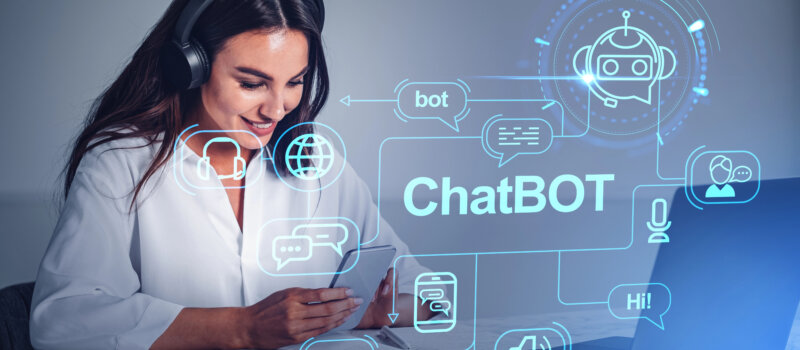Retailers face growing pressure to serve customers faster, personalize experiences, and operate more efficiently, all while keeping costs in check. One of the most effective tools for meeting these demands is the retail chatbot.
A retail chatbot is a virtual assistant that interacts with customers through digital channels like websites, mobile apps, and social platforms. Powered by either AI or rule-based logic, these bots can answer questions, recommend products, resolve issues, and assist with purchases in real time.
This article explores how retail chatbots work, where they add the most value, and what retailers should consider when implementing them.
Quick Takeaways
- A retail chatbot is a virtual assistant that helps customers with product discovery, service requests, and purchase support across digital and in-store channels.
- Chatbots improve customer engagement, speed up service, and increase conversion while reducing costs.
- When integrated with CRM, inventory, and eCommerce platforms, chatbots help retailers deliver a seamless and scalable experience.
- Implementation should focus on real use cases, clear escalation paths, and continuous performance monitoring.
What Is a Retail Chatbot?
A retail chatbot is an automated tool that communicates with customers via text or voice interfaces. Unlike static FAQs or generic contact forms, chatbots engage in dynamic, two-way conversations, helping shoppers navigate the buying journey from start to finish.

Retail chatbots may be powered by artificial intelligence, which enables them to interpret customer intent, personalize responses, and learn over time. Others follow decision-tree logic with predefined responses. Both types can support customer inquiries, guide product discovery, or automate post-sale interactions like order tracking and returns.
Common Use Cases in Retail
Retail chatbots are versatile and can support multiple functions across eCommerce and in-store operations.
Product Discovery and Recommendations
Chatbots help customers find the right product quickly by asking a few questions and narrowing down options. They may suggest products based on style preferences, previous purchases, or seasonal trends. This personalized experience mimics the role of a helpful in-store associate, without requiring one.
Order Tracking and Shipping Updates
Customers frequently reach out about the status of their orders. A chatbot can pull tracking details directly from fulfillment systems and deliver real-time updates through chat, reducing the number of tickets agents must handle manually.
Customer Support and Returns
Retail chatbots can answer basic service questions, such as return policies, store hours, and warranty terms. They can also guide users through return or exchange requests, generate return labels, and even schedule pickups when integrated with logistics providers.
Promotions and Upselling
Bots can promote limited-time offers, suggest bundle deals, or upsell accessories at checkout.

By integrating with product and sales data, a retail chatbot can identify high-converting upsell opportunities based on customer behavior.
In-Store Assistance
Retailers are also using chatbots within physical stores. SMS bots or touchscreen kiosks can help customers locate items, check stock availability, or get directions inside large retail locations. This improves the in-store experience and reduces pressure on sales staff.
Key Benefits of Retail Chatbots
Retail chatbots deliver measurable business value across the customer experience and operational performance.
24/7 Customer Engagement
Chatbots are always available. Whether it’s midnight or a holiday weekend, customers can get immediate support without waiting for business hours. This improves customer satisfaction and keeps shoppers engaged even after traditional staff hours.
Faster Response Times
Chatbots provide instant answers to routine questions, helping customers move forward without delay. This reduces bounce rates on eCommerce sites and shortens time to resolution for service inquiries.
Increased Sales and Conversion
By recommending products, addressing objections, and supporting checkout decisions in real time, chatbots help reduce cart abandonment. They can also identify cross-sell and upsell opportunities, leading to higher average order values.
Consistent, Accurate Information
Unlike human agents, bots don’t forget policies or misstate return windows. They provide consistent answers across all channels, helping reinforce trust and brand credibility.
Cost Efficiency
Retail chatbots reduce the workload on customer support teams by handling thousands of interactions simultaneously. Businesses can scale service delivery without hiring additional agents, lowering the total cost of support.
Integration and Automation Capabilities
Retail chatbots become even more powerful when integrated into a broader communication and data ecosystem. They can connect with:
- Inventory and product databases: To provide real-time availability and pricing
- Order management systems: To deliver updates and process returns
- CRM and loyalty platforms: To personalize recommendations and messages
- Helpdesk tools: To escalate tickets and sync with live agents
- eCommerce platforms: To support add-to-cart, checkout, or payment flows
Retailers can also automate workflows such as abandoned cart follow-up, promotion delivery, and post-purchase satisfaction checks using chatbots as the trigger.
Implementation Considerations
While chatbot technology is accessible, success depends on careful planning and execution.
- Choose the right chatbot type: AI-powered bots offer more natural interactions, but rule-based bots can be highly effective for defined processes like order tracking or store hours.
- Train your bot with real customer data: Use past support tickets, chat logs, and product info to train responses. Regularly update content as products, policies, or promotions change.
- Ensure smooth escalation: When a customer needs more help, the bot should quickly route them to a live agent, ideally without requiring them to repeat their question.
- Test across devices and platforms: Make sure the chatbot works reliably on mobile, desktop, and third-party platforms like Facebook Messenger or WhatsApp.
- Monitor key metrics: Track deflection rates, resolution times, conversions, and customer satisfaction scores to evaluate and optimize chatbot performance.
Prepare Your Retail Business for Smarter Support with Intermedia
As shopping habits shift toward instant, self-service interactions, chatbots offer a scalable solution for delivering consistent support and driving revenue. Whether assisting online customers or supporting in-store shoppers, retail chatbots are becoming a must-have tool for modern customer engagement.
Intermedia’s cloud communication and contact center solutions make it easy to integrate chatbots across your retail channels. Support your customers with fast, consistent service–anytime, anywhere. Request a demo today.





